Lead generation—the process of getting potential customers interested in your business—is one of the most important parts of any marketing strategy today.
Whether it’s done through blog content, paid ads, email campaigns, or social media posts, businesses need to find smart and effective ways to grab people’s attention and turn it into action.
So, what’s working for marketers right now, and how are they moving people from curious clickers to serious buyers?
These up-to-date lead generation stats reveal what’s driving results in 2025 and where your strategy should be focused.
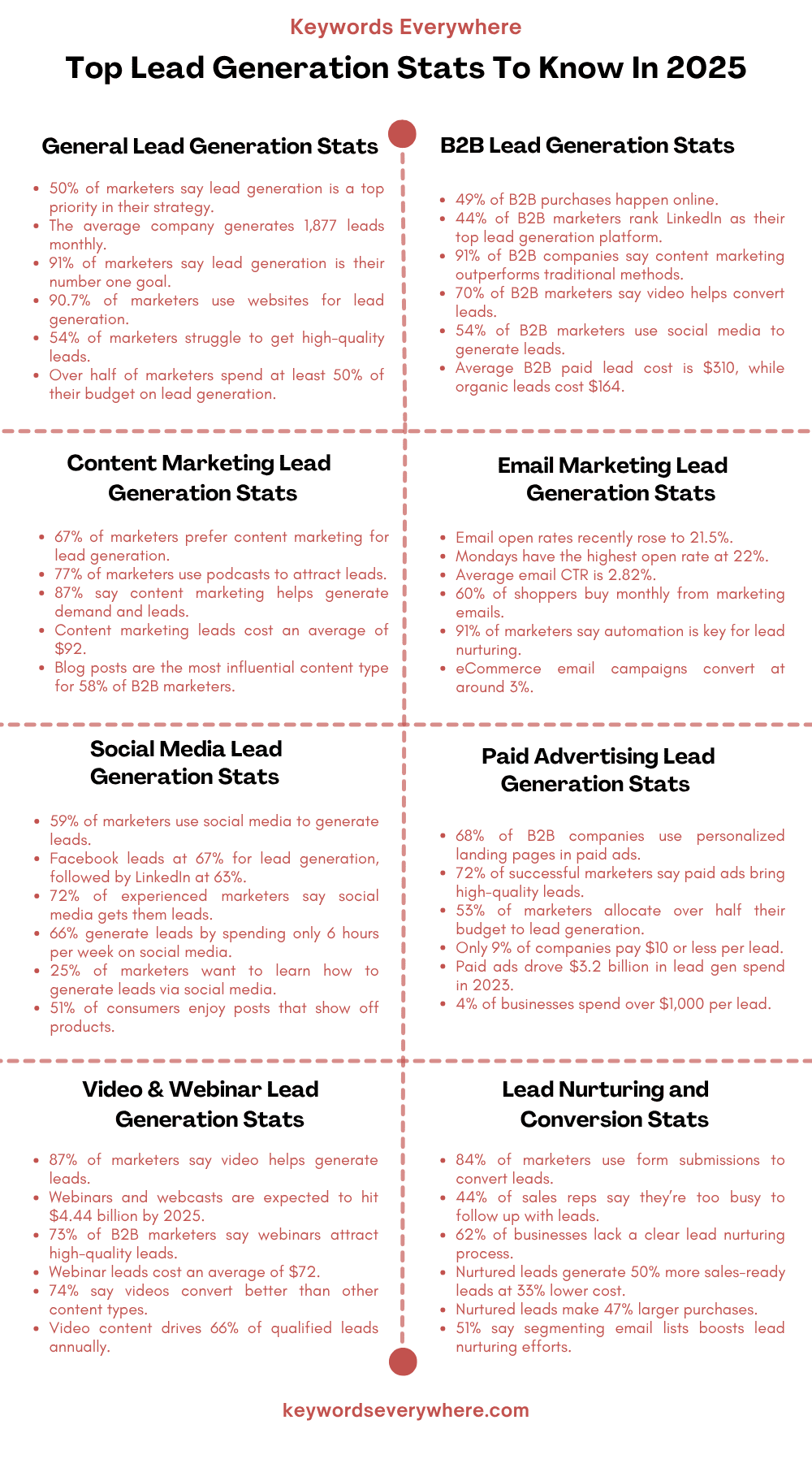
General Lead Generation Stats
Lead generation plays a big role in every marketer’s strategy, no matter what industry they’re in.
Whether it’s through organic traffic, paid ads, or email sign-ups, businesses rely heavily on new leads to grow their reach and build long-lasting relationships with customers.
So how much are companies spending on lead generation, and what’s actually working in today’s landscape?
These general lead generation stats cover all the basics:
1. 50% of all marketers say lead generation is one of the most important parts of their marketing efforts.
2. The average company brings in around 1,877 leads every month, and about 4 out of 5 of those are considered qualified, meaning they have a good chance of turning into customers.
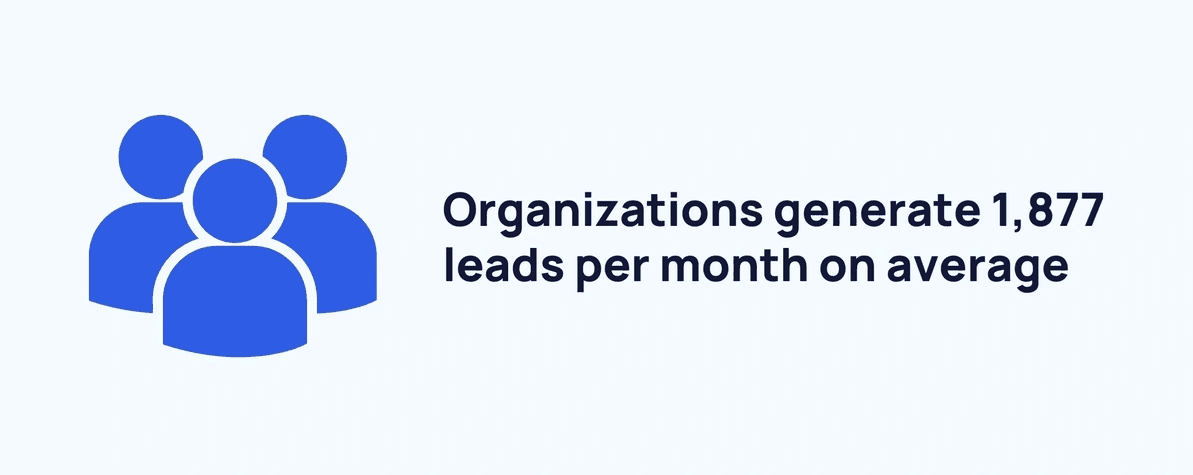
Lead generation per month
3. Only 9% of businesses spend $10 or less per lead, while a small group—around 4%—spends over $1,000 for each one. Surprisingly, 18% of marketers don’t even know how much they’re paying per lead.
4. A recent report by FirstPageSage found that the average cost per organic lead is $164 for B2B SaaS, $83 for eCommerce, and $385 for IT and managed service providers.
5. An overwhelming 91% of marketers say lead generation is their top goal, mainly because finding quality leads is what helps bring in real sales.
6. More than half of marketers (54%) say their biggest challenge is getting better-quality leads, while 41% struggle to get more leads in general, showing how tough the process can be.
7. Websites are the most-used tool for lead generation, with 90.7% of marketers using them, and blogs follow closely behind at 89.2%, proving that online content still plays a major role in attracting leads.

Top channels for lead generation
8. Over half of marketers say they spend at least 50% of their marketing budget on lead generation, making it one of the biggest investments in their strategy.
9. According to The Insights Partner, the global lead generation market is expected to reach $15.55 billion by 2031, growing at a steady rate of 17.5% annually. Currently, the market is valued at approximately $4.28 billion, based on 2023 data.
10. According to Keywords Everywhere, over 8,000 people search for lead generation companies on Google every month, highlighting the number of businesses actively seeking expert help in this space.
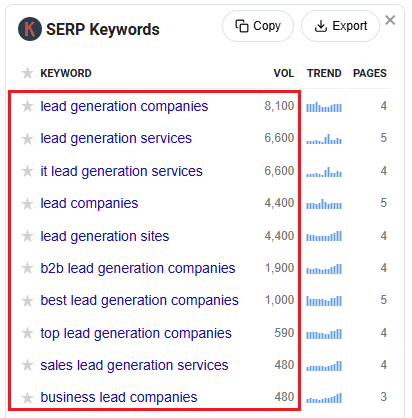
B2B Lead Generation Stats
B2B companies face a very different challenge when it comes to generating leads, with longer buying cycles and more decision-makers involved.
Creating trust, offering value, and using the right platforms are all key factors in turning potential clients into qualified leads.
But what are other B2B marketers doing to stay ahead, and how are they measuring their success?
These B2B lead generation stats show exactly where things stand and what’s making the biggest impact.
11. 49% of B2B purchases now take place online, and 68% of buyers say they’ll rely even more on digital channels in the future, showing a strong shift toward online sales.
12. According to Social Media Examiner, LinkedIn is the top platform for B2B lead generation, with 44% of marketers ranking it first. Facebook comes second with 33%, making it another key player.
13. 72% of B2B marketers plan to grow their organic presence on LinkedIn, and 52% want to learn how to use LinkedIn ads to bring in more traffic and leads.

B2B marketers use of organic social media platforms
14. 91% of B2B companies say content marketing brings in more leads than traditional methods, proving that valuable content still makes a strong impact.
15. The average B2B conversion rate is 2.9%, but companies offering higher-priced products or services usually convert at a lower rate.
16. 70% of B2B marketers believe video content helps convert leads, and 68% use landing pages as a main part of their lead generation strategy.
17. 44% of B2B marketers state email marketing is a helpful tool for getting leads, while half say it’s the most effective channel overall.
18. 54% of B2B marketers use social media for lead generation, and companies with social selling strategies see 48% larger deal sizes on average.
19. A First Page Sage report found that the average cost per lead in B2B is $310 for paid ads, $164 for organic leads, and $237 when using a mix of both.

Average cost per lead for different B2B marketing channels
Content Marketing Lead Generation Stats
Content has become one of the most powerful tools for attracting leads in today’s digital world.
From blog posts and SEO pages to whitepapers and downloadable guides, the right content can bring in interested prospects without any hard selling.
These lead generation stats reveal how much content matters, how it performs, and how marketers are using it to fill their pipelines.
20. 67% of marketers say content marketing is their favorite way to generate leads, showing just how important it’s become in today’s digital strategies.
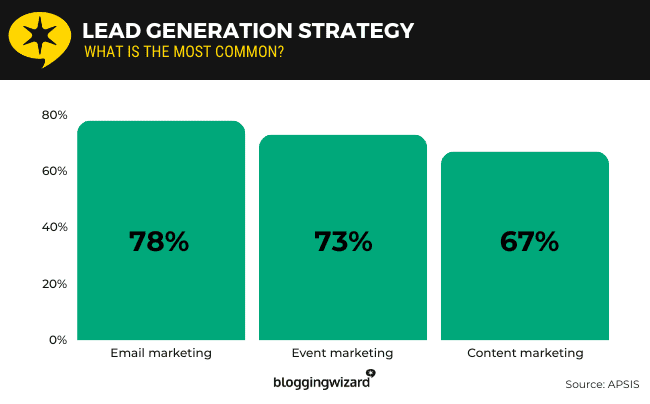
Most common lead generation strategy
21. According to the Content Marketing Institute (CMI), 77% of marketers are using podcasts to create content and attract leads, making it one of the most preferred content formats.
22. Forbes reports that 74% of marketers believe content marketing plays a big role in helping them get more leads, showing strong confidence in its impact.
23. According to CMI’s 2024 data:
- 87% of marketers say content marketing helps generate demand and leads, up 11% from the year before.
- 74% say it helps nurture audiences and build relationships, also up 11%.
- 52% think it strengthens customer loyalty, though that’s down slightly from last year.
24. The average cost of generating a lead through content marketing is $92, according to HubSpot’s latest benchmark report.
25. HubSpot also found that content marketing brings an average return on investment (ROI) of 14%, showing it delivers solid value over time.
26. 58% of B2B marketers say blog posts are the most influential content type for generating leads, followed by case studies (53%), eBooks and white papers (45%), research reports (45%), and short articles or posts (43%).

Types of content that produce best results for marketers
Email Marketing Lead Generation Stats
Email may be one of the oldest tools in digital marketing, but it’s still one of the most effective for generating leads.
Marketers continue to rely on newsletters, welcome emails, and nurture campaigns to engage subscribers and move them down the funnel.
But what kinds of email strategies actually work best? These email lead generation stats offer all the answers you need.
27. Only about 1 in 5 marketing emails are actually opened, with open rates varying by industry—retail has one of the lowest rates at 17.1%, while education leads the pack at 28.5%.
28. Recently, email open rates have climbed to 21.5%, which is a 3.5% increase, but click rates within emails have dropped by 3.6% during the same time.
29. Mondays see the highest open rate at 22%, while Tuesdays have the best click-through rate at 2.4%, and click-to-open rates peak on Tuesdays and Wednesdays at 10.8%.

Email marketing benchmarks
30. The average click-through rate (CTR) for email campaigns is 2.82%, but this can change a lot depending on things like your industry, your email list quality, and how well your emails are written.
31. In a survey of 1,015 online shoppers, 60% said they make at least one purchase each month because of marketing emails, though only 10% buy weekly and 22% never buy from email promotions.
32. A massive 361.6 billion emails are sent every day, and according to Statista, that number is expected to rise to 408.2 billion per day by 2027.

Number of sent and received e-mails per day worldwide
33. Email marketing campaigns for eCommerce brands average a 3% conversion rate, with welcome emails converting at about 3% and abandoned cart emails averaging 2.39%.
34. 91% of marketers believe marketing automation is essential for successful lead nurturing, and 75% say one of its biggest perks is saving time, especially when it comes to managing email campaigns across channels.
Social Media Lead Generation Stats
With billions of individuals using platforms like LinkedIn, Facebook, and Instagram every day, social media has become a major part of lead generation.
It’s not just about posting content anymore—it’s about running ads, starting conversations, and building trust with an audience that’s always online.
So which platforms are performing best?
These social media lead generation stats break it all down.
35. 59% of marketers use social media platforms to generate leads, showing that platforms like Facebook, LinkedIn, and Instagram play a big role in bringing in new potential customers.
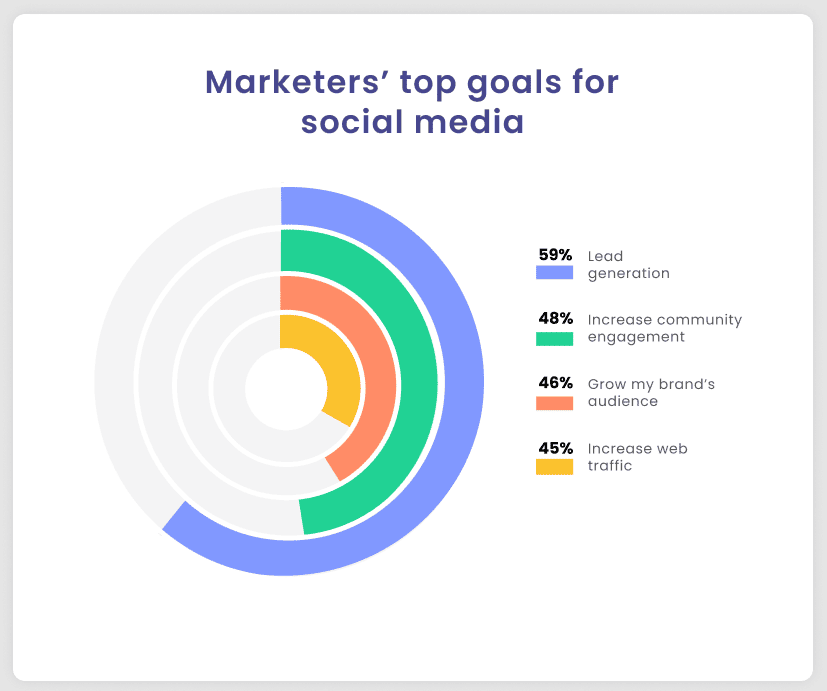
Marketers top goals for social media
36. While social media works well, experience makes a difference—72% of marketers with 5+ years of experience say social media helps them get leads, compared to only 42% of those with less than a year of experience.
37. In Social Media Examiner’s 2022 survey of over 2,000 marketers, 25% said the thing they most wanted to learn was how to generate leads through social media.
38. When asked what kinds of posts they enjoy most, 51% of consumers said they like seeing content that shows off a brand’s products, while only 14% said they prefer behind-the-scenes posts.
39. Facebook is the most popular platform for lead generation at 67%, followed closely by LinkedIn at 63% and Instagram at 62%, making all three essential channels.
40. 66% of marketers say they’re able to generate leads by spending only six hours every week on social media marketing, proving you don’t always need a massive time investment to get results.

Six hours are enough to drive leads from social media
Paid Advertising Lead Generation Stats
Paid advertising gives businesses a fast and targeted way to reach potential leads online.
Whether it’s Google Ads, Facebook Ads, or promoted posts on other platforms, these campaigns are often the quickest way to generate traffic and interest.
These lead generation stats show what marketers are spending and what’s working best in 2025.
41. 68% of B2B companies use personalized landing pages in their paid marketing campaigns to help turn visitors into leads more effectively.
42. According to Sender, 72% of marketers who consider themselves successful say paid ad campaigns bring in high-quality leads. However, it’s worth noting that this reflects the views of marketers already seeing good results.
43. Only 9% of companies pay $10 or less per lead, while 4% spend over $1,000 per lead.
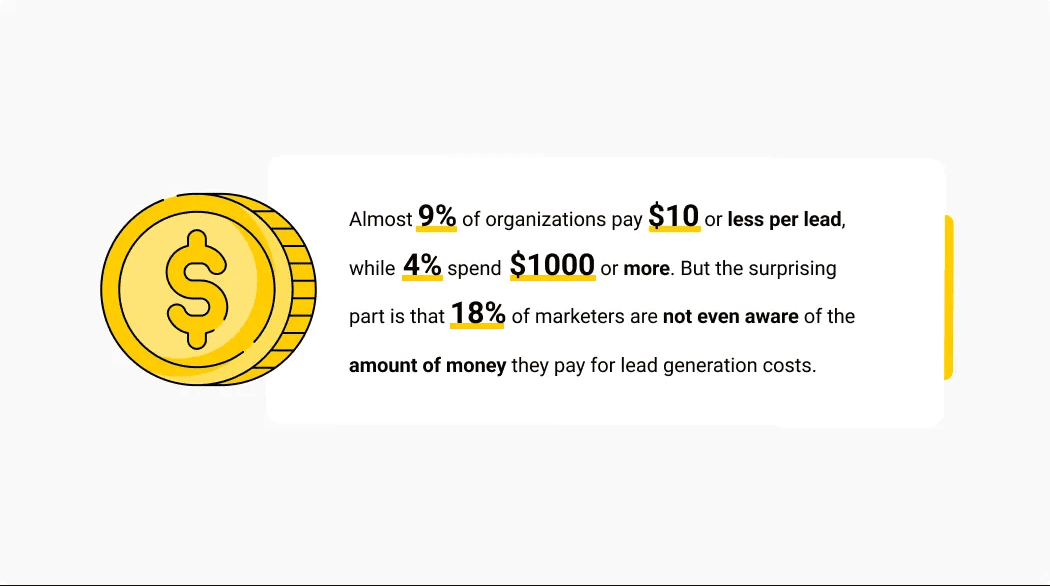
How much organizations pay per lead
44. 53% of marketers dedicate more than half of their total budget to lead generation, showing how seriously businesses invest in finding new customers.
45. In 2023 alone, marketers spent an estimated $3.2 billion on paid ads to drive lead generation, highlighting the massive scale of investment in paid media strategies.
Video & Webinar Lead Generation Stats
Video content has exploded in recent years, and it’s now one of the top ways brands are connecting with potential leads.
From short-form videos on social media to in-depth webinars that teach and sell simultaneously, this type of content draws people in and keeps them engaged.
But how well does it convert, and how are marketers using it to build their email lists and pipelines? These stats tell the full story of video and webinar lead generation.
46. According to GlobeNewswire, the webinar and webcast market is expected to grow to $4.44 billion by 2025, showing just how valuable these tools have become for engaging audiences and generating leads.
47. 73% of B2B marketers say webinars are one of the most useful ways to attract high-quality leads, especially when targeting decision-makers.
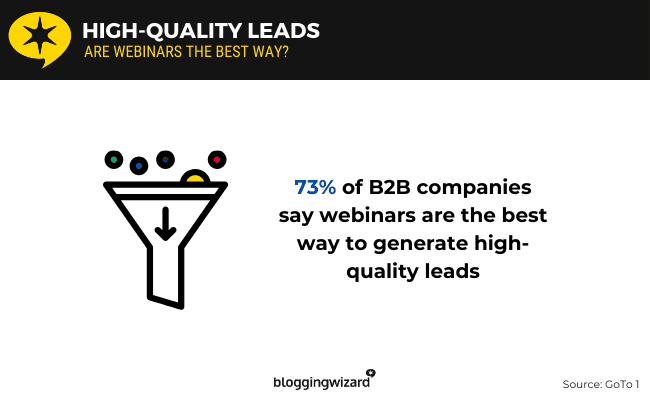
Webinars generate high-quality leads
48. A survey by Contrast found that most webinar sign-ups happen early in the week, with 21% on Tuesday, 20.3% on Thursday, and 19% on Monday.
49. The average cost to generate a lead through webinars is just $72, which makes them a more affordable option compared to channels like pay-per-click advertising.
50. According to Vidco, 87% of marketers say they’ve successfully used videos to generate leads, showing how strong video content can be when trying to capture attention.
51. 74% of marketers say videos perform better than any other content type when it comes to driving conversions.
52. 27.2% of marketers actively use video campaigns to generate more leads, showing that many are already tapping into their potential.
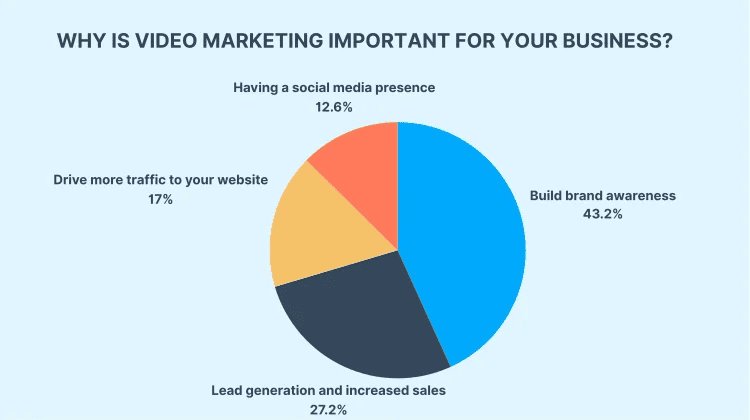
Video marketing helps businesses in generating leads
53. Video content is responsible for about 66% of qualified leads every year.
Lead Nurturing and Conversion Stats
Getting leads is only the beginning—the real challenge is turning them into paying customers.
Lead nurturing involves staying in touch, offering value, and moving people through the funnel until they’re ready to buy.
These lead nurturing and conversion stats explain how brands are making the most of every lead they get.
54. 84% of marketers use form submissions to convert leads, while about half (50.3%) still use phone calls, and 33.2% use live chat, showing that digital and traditional methods are both still in play.

Most common lead conversion methods
55. 44% of sales reps say they’re too busy to follow up with leads, and even though there are tools to help automate this process, only 1 in 4 sales teams use them.
56. The biggest frustration sales reps have with inbound leads is poor quality—44% complain about bad leads, 39% say most leads aren’t ready to buy, and 37% say they struggle to reach people.
57. 62% of businesses admit they don’t have a clear process for nurturing leads, which makes it harder to turn interest into actual sales.
58. When it comes to email, 51% of marketers say segmenting their email lists is the most effective way to personalize and improve lead nurturing efforts.
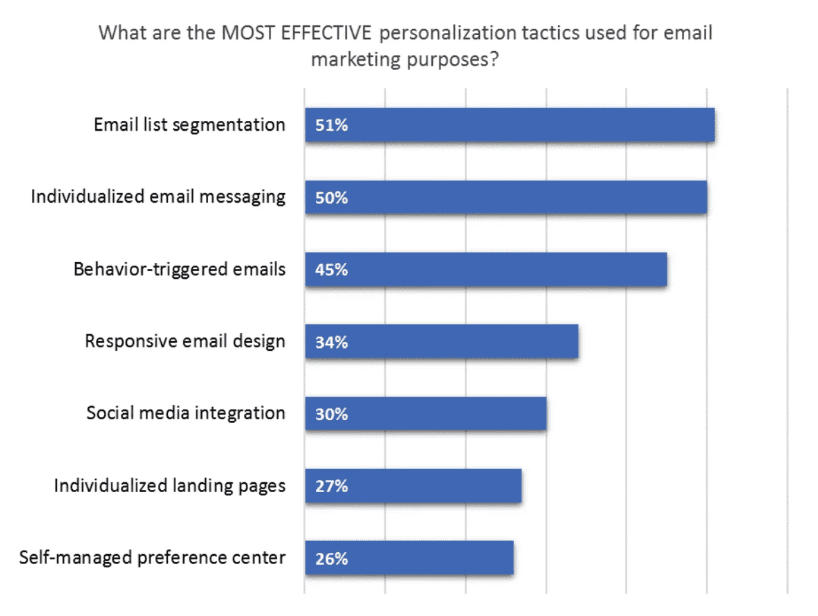
Most effective personalization tactics used for email marketing purposes
59. Companies that nurture leads well generate 50% more sales-ready leads and do it at 33% less cost, making it a smart and efficient strategy.
60. Nurtured leads also spend more, with data showing they make 47% larger purchases compared to leads that aren’t nurtured—proving that building a relationship really does pay off.
Conclusion
No matter the industry, bringing in fresh leads regularly is what keeps a business moving forward and growing steadily.
Even though lead generation can be challenging, most marketers agree it’s one of the most important pieces of their overall plan.
In 2025, successful teams are blending paid ads, webinars, video, and automation to guide potential buyers from first click to final purchase.
The real winners will be the ones who stay flexible, keep testing, and focus on both quality and long-term relationships.


